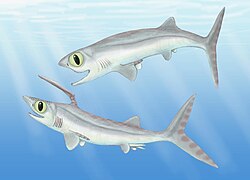| Symmoriiformes Temporal range: Late Devonian - Early Permian (Members of the family Falcatidae might have survived until the Early Cretaceous in Europe.) | |
|---|---|
 | |
| Symmorium | |
| Scientific classification | |
| Domain: | Eukaryota |
| Kingdom: | Animalia |
| Phylum: | Chordata |
| Class: | Chondrichthyes |
| Order: | † Symmoriiformes Zangerl, 1981 (sensu Maisey, 2007) |
| Families and genera | |
Symmoriiformes is an extinct order of cartilaginous fish. Originally named Symmoriida by Zangerl (1981), [1] the name has since been corrected to Symmoriiformes to avoid confusion with a family. [2] The symmoriiform fossils record begins during the late Devonian, and most had become extinct by the start of the Permian, with the genus Dwykaselachus from the Artinskian-Kungurian of South Africa being the latest known uncontroversial occurrence. [3] Teeth described from the Valanginian of France [4] and Austria [5] indicate that members of the family Falcatidae might have survived until the Early Cretaceous; however, it has since been proposed that these teeth more likely belonged to neoselachian sharks. [6]












